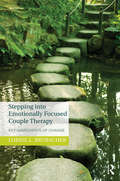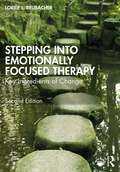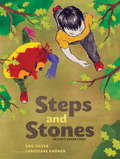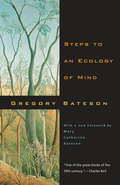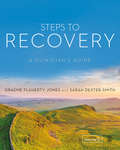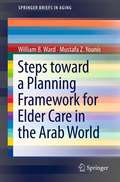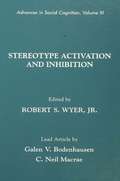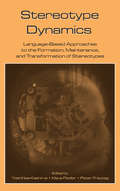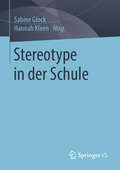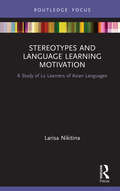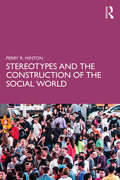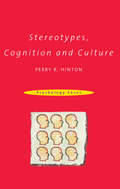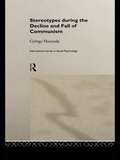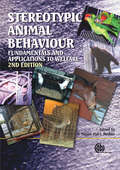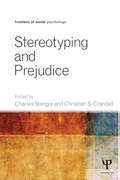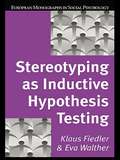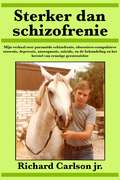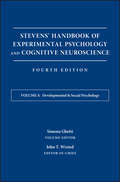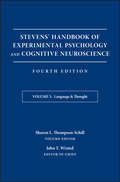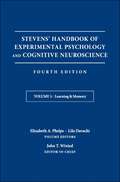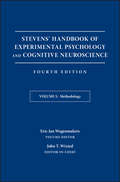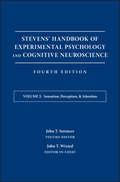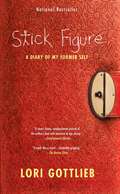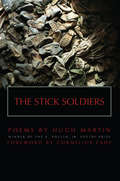- Table View
- List View
Stepping into Emotionally Focused Couple Therapy: Key Ingredients of Change
by Lorrie L. BrubacherThis volume makes Emotionally Focused Couple Therapy (EFT) widely accessible to therapists of different orientations and to therapists in training. It provides clinicians with practical tools, an experiential tour through case examples, and simple guidance to step into EFT. An overview of the change events includes both client processes and therapist interventions moment-to-moment. 'In Stepping into Emotionally Focused Couple Therapy: Key Ingredients of Change, each step and stage of EFT is laid out in a practical and theoretically simple manner that extends beyond what therapists need to do, to helping therapists grasp what experiential therapy is, providing moment-by-moment examples of how to engage clients emotionally, and how to foster emotional engagement between partners.'- From the Foreword by S. Johnson and A. Lee
Stepping into Emotionally Focused Therapy: Key Ingredients of Change
by Lorrie L. BrubacherThis accessible, practical, and thoroughly updated second edition introduces and presents how emotionally focused therapy can be used effectively across all three modalities, couple, family, and individual therapy, with clients from a diversity of backgrounds.Responding to critical updates in the field, this second edition once again follows Emily, an EFT therapist, to demonstrate how EFT can be used in practice. With updated references, research, and terminology throughout, this new edition reflects recent theoretical and practical updates by refocusing the model toward therapist interventions, such as the "EFT Tango," rather than the client change events, making it more accessible for readers to learn. It addresses the current need to integrate explicit socio-cultural sensitivity into EFT by including diverse case studies, explicit discussion of how the model can be applied with a diversity of clients, and how EFT therapists can integrate cultural sensitivity and attunement across multiple and diverse identities, such as race, gender, sexual orientation, disabilities, neurotypicality, class, and religion. It can also be used alongside a practical new workbook, Workouts for Stepping into Emotionally Focused Therapy, providing therapists with all the tools needed to confidently integrate this approach into their practice.This book is an essential read for all marriage and family therapists in practice and in training as well as counselors who are looking to use EFT with couples, families, and individuals.
Steps and Stones
by Gail Silver Christiane KromerWhen Anh's friends leave and he feels left out at school, his anger shows up to keep him company. Anh the protagonist of Gail Silver's previous book Anh's Anger, is a typical and easy-to-relate-to elementary school-age boy. His anger, personified as a red hairy impulsive creature, teaches him some valuable lessons about not getting carried away by his strong emotions. By counting his steps and coordinating them with his breathing Anh is able to slow down and take his anger for a peaceful and magically transformative walk.Reach and Teach.com called Anh's Anger, "One of the best books we've ever seen on the issue of dealing with anger." The New Yorker review highlighted how the book uses "deep breathing... to regain control during a tantrum." And Zen Master Thich Nhat Hanh calls the Anh's Anger series, "a wonderful gift for both children and adults who want to learn how to turn unhappy situations into joyful ones."Steps and Stones the second of the Anh's Anger Story trilogy will help children learn to understand the causes of their own strong emotions, and teaches them peaceful ways to resolve difficulties through mindfulness and meditation. An invaluable tool for parents and teachers alike.Steps and Stones is beautifully illustrated by New York artist and children's book illustrator Christiane Krömer. Using a mix of paper, acrylic, cardboard, and found materials, her vibrant multi-textured collages reflect the connection between the characters and their environment and echo the wide range of emotions that come together in the story.Gail Silver writes: "If, at an early age, children become comfortable with identifying and articulating their anger, then they can feel confident working through anger in healthy ways during their adolescent years. There is a lot of adolescent violence in the news today. I am overwhelmed with pain and sadness every time I hear of an adolescent using a gun. While these teens are deeply troubled and have many problems, unresolved anger plays a part in their difficulty. I hope these books can be used as a preventative resource. We can only practice what we know or what we are willing to learn. My hope is that the Anh's Anger stories can contribute to a decrease in adolescent aggression and violence by teaching children at an early age how to safely understand and express their anger."
Steps to an Ecology of Mind
by Gregory BatesonGregory Bateson was a philosopher, anthropologist, photographer, naturalist, and poet, as well as the husband and collaborator of Margaret Mead. With a new foreword by his daughter Mary Katherine Bateson, this classic anthology of his major work will continue to delight and inform generations of readers. "This collection amounts to a retrospective exhibition of a working life. . . . Bateson has come to this position during a career that carried him not only into anthropology, for which he was first trained, but into psychiatry, genetics, and communication theory. . . . He . . . examines the nature of the mind, seeing it not as a nebulous something, somehow lodged somewhere in the body of each man, but as a network of interactions relating the individual with his society and his species and with the universe at large. "—D. W. Harding, New York Review of Books "[Bateson's] view of the world, of science, of culture, and of man is vast and challenging. His efforts at synthesis are tantalizingly and cryptically suggestive. . . . This is a book we should all read and ponder. "—Roger Keesing, American Anthropologist Gregory Bateson (1904-1980) was the author of Naven and Mind and Nature.
Steps to Recovery: A clinician's guide
by Graeme Flaherty-Jones Sarah Dexter-SmithWith each chapter representing a session, this engaging book is a guide to working collaboratively with individuals and incorporating recovery principles into your therapeutic practice. Incorporating both philosophical and theoretical background, the authors guide the reader through each session with highlights of what to do when, key points for thought, and notes of caution. With access to downloadable worksheets to use with clients in session, as well as crib sheets to help keep you on track, you will have everything you need to confidently help people on their recovery journey.
Steps to Recovery: A clinician′s guide
by Graeme Flaherty-Jones Sarah Dexter-SmithWith each chapter representing a session, this engaging book is a guide to working collaboratively with individuals and incorporating recovery principles into your therapeutic practice. Incorporating both philosophical and theoretical background, the authors guide the reader through each session with highlights of what to do when, key points for thought, and notes of caution. With access to downloadable worksheets to use with clients in session, as well as crib sheets to help keep you on track, you will have everything you need to confidently help people on their recovery journey.
Steps Toward a Planning Framework for Elder Care in the Arab World
by Mustafa Z. Younis William B. WardThis book reviews the elder care literature pertaining to the Arab world and proposes steps that can be taken to improve the health and quality of life of older people in this region. Organized in three main sections (Program Assessment, Program Planning, Conclusions and Recommendations), the book addresses such topics as developing a conceptual framework; Arab world elder demographics; quality of life issues; demand for services; training issues; training capacity and capabilities; and conclusions and recommendations for improving the health of older persons in the Arab world. While the countries of the Arab world have the advantage of a unified language and culture that can be used to expedite development of area-wide approaches to a system of elder care, the lack of economic and political unification (such as common market and open trade) along with institutionalized age discrimination (some Arab countries restrict hiring for government and private jobs to persons younger than 45) present barriers to improving the health of older people. In addition, modernization and ease of transportation have resulted in a heavy focus on Western-style fast food, with an accompanying increase in chronic diseases such as hypertension, cardiovascular disease, diabetes, and cancer.
Stereotype Activation and Inhibition: Advances in Social Cognition, Volume XI (Advances in Social Cognition Series #Vol. 11)
by Robert S. WyerThe use of social sterotypes as a basis for judgments and behavioral decisions has been a major focus of social psychological theory and research since the field began. Although motivational and cognitive influences on stereotyping have been considered, these two general types of influence have rarely been conceptually integrated within a common theoretical framework. Nevertheless, almost every area of theoretical and empirical concern in social cognition--areas such as the interpretation of new information, memory and retrieval processes, impression formation, the use of heuristic vs. analytic processing strategies, the role of affect in information processing, and self-esteem maintenance--has implications for this important social phenomenon. This volume's target article brings together the research of Galen Bodenhausen, Neil Macrae, and others within a theoretical framework that accounts for the processes that underlie both the activation of stereotypes and attempts to suppress their influence. They consider several stages of processing, including: *the categorization of a stimulus person; *the influence of this categorization on the interpretation of information about the stimulus person; and *the social judgments and behavioral decisions that are ultimately made. The stereotype activation and suppression mechanisms that the target article authors consider operate at all of these stages. Their conceptualization provides a framework within which the interrelatedness of processing at these stages can be understood. The 11th in the series, this volume includes companion articles that help to refine and extend the target article's conceptualization and make important theoretical contributions in their own right. They are written by prominent researchers in cognitive and social psychology, many of whom are active contributors to research and theory on stereotyping. They address the following topics: * the role of power and control in stereotype-based information processing; * the influence of prejudice; * self-regulatory processes; * social categorization; * the correction processes that result from perceptions of bias; and * the conceptualization of stereotypes themselves.
Stereotype Dynamics: Language-Based Approaches to the Formation, Maintenance, and Transformation of Stereotypes
by Yoshihisa Kashima Klaus Fiedler Peter FreytagThis volume addresses the role of communication in stereotype dynamics, while placing the phenomenon of social stereotypes appropriately in the socio-cultural context. Stereotype Dynamics assembles top researchers in the field to investigate stereotype formation, maintenance, and transformation through interpersonal facets of communication.Section
Stereotype in der Schule
by Sabine Glock Hannah KleenDas Buch liefert neue, in Deutschland noch relativ unbekannte Forschung zum Einfluss von Stereotypen in der Schule und einen hervorragenden theoretischen und empirischen Überblick zu dem Themenkomplex. Beschrieben und analysiert werden vor allem Stereotype im Kontext unterschiedlicher Merkmale von Schüler*innen wie Geschlecht, sonderpädagogischem Förderbedarf, Migrationsverhältnisse und sozio-ökonomischem Status.
Stereotypes and Language Learning Motivation: A Study of L2 Learners of Asian Languages
by Larisa NikitinaThis book explores stereotypes that learners of six Asian languages— Japanese, Mandarin, Korean, Myanmar, Thai and Vietnamese—hold about the target language country, its cultures and people. Some of the findings, such as the language learners’ mental images of Myanmar, Thailand and Vietnam, are presented here for the first time. Recognizing that stereotypes, and attitudes embedded in them, have an impact on people’s actions and behavioural intentions, this book examines whether and how the country stereotypes held by the students influenced their motivation to learn the target language. Besides providing worthwhile insights into the content and structure of the country stereotypes and their relationship with language learning motivation, this book offers methodological and theoretical advancements. Drawing on intellectual heritage of Russian psychologist Lev Vygotsky (1896-1934) the book highlights how the concepts of word meaning (znachenie slova) and word sense (smysl) could be fruitfully employed in studies on stereotypes that people learning a foreign language hold about a target language country. This book will appeal to all readers interested in stereotypes that people have about foreign countries and also to educators and researchers who study language learning motivation.
Stereotypes and the Construction of the Social World
by Perry HintonStereotypes and the Construction of the Social World explores the complexity of stereotypes, guiding the reader through issues of definition and theoretical explanations from psychology and other disciplines. The book examines why people use stereotypes, which have often been represented as inaccurate, rigid and discriminatory. If that is what they are, then why would people employ such ‘faulty’ or ‘biased’ views of others? <p> Whilst this book presents a detailed and comprehensive analysis of the psychological research into the individual use of stereotypes, it also presents this research within its ideological and historical context, revealing the important sociocultural factors in what we mean by ‘stereotypes’. From the politics of representation and inter-group power relations, alongside individual social cognitive issues, the book provides a comprehensive and cross-disciplinary account of stereotypes and stereotyping.
Stereotypes, Cognition and Culture
by Dr Perry HintonWhat are stereotypes and why do we use them? Are all stereotypes bad? Can we stop people from using them? Questions such as these have fascinated social psychologists for many years.Perry Hinton provides an accessible introduction to this key area, giving a critical and concise overview of the influential theories and approaches, as well as insights into recent work on the role of language and culture in stereotyping.
Stereotypes During the Decline and Fall of Communism (International Series in Social Psychology)
by Gyorgy HunyadyUnique among the satellites of the Soviet Union, Hungary has data from a series of fourteen substantial surveys from the mid-1960s through to 1994. How do Hungarians think about themselves, their history, their society and other countries and their peoples? Hunyady provides an excellent summary of investigations examining these questions, analysing them against the background of the social psychology literature of stereotypes.
Stereotypic Animal Behaviour: Fundamentals and Applications to Welfare
by Georgia Mason Jeffrey RushenAbnormal behavior patterns, from the jumping and somersaulting of caged laboratory mice to the pacing of enclosed 'big cats', are displayed by many millions of farm, zoo, research and companion animals. Including new chapters and over 30 contributors, this book focuses on the causation and treatment of these environment-induced stereotypic behaviors, and their implications for animal welfare and normalcy of brain functioning. The book begins by taking an ethological perspective, focusing on the constraints captivity places on animals' normal behavioral repertoires, and the effects these have on specific motivational systems. It then addresses the role of dysfunction, particularly the impact of chronic stress and impoverished environments on brain functioning. The book then moves on to explore how stereotypic behaviors can be tackled, once they have emerged, using diverse techniques from environmental enrichment to pharmaceutical intervention. It concludes by giving a new definition for 'stereotypic behavior', and a discussion of future research directions.
Stereotyping and Prejudice: Key Readings (Frontiers of Social Psychology)
by Charles Stangor Christian S. CrandallThis volume presents a contemporary and comprehensive overview of the great diversity of theoretical interests, new ideas, and practical applications that characterize social psychological approaches to stereotyping and prejudice. All the contributions are written by renowned scholars in the field, with some chapters focusing on fundamental principles, including research questions about the brain structures that help us categorize and judge others, the role of evolution in prejudice, and how prejudice relates to language, communication, and social norms. Several chapters review a new dimension that has frequently been understudied—the role of the social context in creating stereotypes and prejudice. Another set of chapters focuses on applications, particularly how stereotypes and prejudice really matter in everyday life. These chapters include studies of their impact on academic performance, their role in small group processes, and their influence on everyday social interactions. The volume provides an essential resource for students, instructors, and researchers in social and personality psychology, and is also an invaluable reference for academics and professionals in related fields who have an interest in the origins and effects of stereotyping and prejudice.
Stereotyping as Inductive Hypothesis Testing (European Monographs in Social Psychology)
by Klaus Fiedler Eva WaltherTraditional social hypotheses have a built-in tendency to verify themselves and so involuntarily resist attempts at stereotype change or correction. This is the insight demonstrated and discussed as the start point for an alternative approach to the problem of stereotyping and hypothesis testing. Stereotyping as Inductive Hypothesis Testing explicates the proposition that many stereotypes originate not so much in individual brains, but in the stimulus environment that interacts with and constitutes the social individual. This cognitive-ecological approach is then used to analyse the different aspects of language, sign systems and communication that can implicitly govern hypothesis testing procedures and lead to circular or reinforcing outcomes. The authors describe factors in tests such as judgment, memory and expectation and go on to suggest viable ecological learning approaches to them. An original research project based on a classroom situation is used to demonstrate and verify findings. The cognitive-ecological approach is then contextualised in relation to both the traditional approaches it can replace and the contemporary statistical sampling practices it can improve. Written with a profound understanding of the link between theoretical rigour and good empirical research practice this monograph will be invaluable to anyone with an interest in stereotyping or who wishes to enhance the reliability and self-awareness of their research methods.
Sterker dan schizofrenie
by Audrey Liauw Richard Carlson Jr.Mijn verhaal over paranoïde schizofrenie, obsessieve-compulsieve stoornis, depressie, anosognosie, suïcide, en de behandeling en het herstel van ernstige geestesziekte
Stevens' Handbook of Experimental Psychology and Cognitive Neuroscience, Developmental and Social Psychology: Learning And Memory
by John T. Wixted Simona GhettiIV. Developmental & Social Psychology: Simona Ghetti (Volume Editor) (Topics covered include development of visual attention; self-evaluation; moral development; emotion-cognition interactions; person perception; memory; implicit social cognition; motivation group processes; development of scientific thinking; language acquisition; development of mathematical reasoning; emotion regulation; emotional development; development of theory of mind; category and conceptual development; attitudes; executive function.)
Stevens' Handbook of Experimental Psychology and Cognitive Neuroscience, Language and Thought
by John T. Wixted Sharon L. Thompson-SchillIII. Language & Thought: Sharon Thompson-Schill (Volume Editor) (Topics covered include embodied cognition; discourse and dialogue; reading; creativity; speech production; concepts and categorization; culture and cognition; reasoning; sentence processing; bilingualism; speech perception; spatial cognition; word processing; semantic memory; moral reasoning.)
Stevens' Handbook of Experimental Psychology and Cognitive Neuroscience, Learning and Memory: Learning And Memory
by John T. Wixted Elizabeth A. Phelps Lila DavachiI. Learning & Memory: Elizabeth Phelps & Lila Davachi (Volume Editors)Topics covered include working memory; fear learning; education and memory; memory and future imagining; sleep and memory; emotion and memory; motivation and memory; inhibition in memory; attention and memory; aging and memory; autobiographical memory; eyewitness memory; and category learning.
Stevens' Handbook of Experimental Psychology and Cognitive Neuroscience, Methodology
by John T. Wixted Eric-Jan WagenmakersV. Methodology: E. J. Wagenmakers (Volume Editor) Topics covered include methods and models in categorization; cultural consensus theory; network models for clinical psychology; response time modeling; analyzing neural time series data; models and methods for reinforcement learning; convergent methods of memory research; theories for discriminating signal from noise; bayesian cognitive modeling; mathematical modeling in cognition and cognitive neuroscience; the stop-signal paradigm; hypothesis testing and statistical inference; model comparison in psychology; fmri; neural recordings; open science; neural networks and neurocomputational modeling; serial versus parallel processing; methods in psychophysics.
Stevens' Handbook of Experimental Psychology and Cognitive Neuroscience, Sensation, Perception, and Attention: Learning And Memory
by John T. Wixted John SerencesII. Sensation, Perception & Attention: John Serences (Volume Editor) (Topics covered include taste; visual object recognition; touch; depth perception; motor control; perceptual learning; the interface theory of perception; vestibular, proprioceptive, and haptic contributions to spatial orientation; olfaction; audition; time perception; attention; perception and interactive technology; music perception; multisensory integration; motion perception; vision; perceptual rhythms; perceptual organization; color vision; perception for action; visual search; visual cognition/working memory.)
Stick Figure: A Diary of My Former Self
by Lori Gottlieb"I wish to be the thinnest girl at school, or maybe even the thinnest eleven-year-old on the entire planet," confides Lori Gottlieb to her diary. "I mean, what are girls supposed to wish for, other than being thin?" For a girl growing up in Beverly Hills in 1978, the motto "You can never be too rich or too thin" is writ large. Precocious Lori learns her lessons well, so when she's told that "real women don't eat dessert" and "no one could ever like a girl who has thunder thighs," she decides to become a paragon of dieting. Soon Lori has become the "stick figure" she's longed to resemble. But then what? Stick Figure takes the reader on a gripping journey, as Lori struggles to reclaim both her body and her spirit. By turns painful and wry, Lori's efforts to reconcile the conflicting messages society sends women ring as true today as when she first recorded these impressions. "One diet book says that if you drink three full glasses of water one hour before every meal to fill yourself up, you'll lose a pound a day. Another book says that once you start losing weight, everyone will ask, 'How did you do it?' but you shouldn't tell them because it's 'your little secret. ' Then right above that part it says, 'New York Times bestseller. ' Some secret. " With an edgy wit and keenly observant eye, Stick Figure delivers an engrossing glimpse into the mind of a girl in transition to adulthood. This raw, no-holds-barred account is a powerful cautionary tale about the dangers of living up to society's expectations.
The Stick Soldiers
by Cornelius Eady Hugh MartinAt age nineteen, Hugh Martin withdrew from college for deployment to Iraq. After training at Fort Bragg, Martin spent 2004 in Iraq as the driver of his platoon sergeant's Humvee. He participated in hundreds of missions including raids, conducting foot patrols, clearing routes for IEDs, disposing of unexploded ordnance, and searching thousands of Iraqi vehicles. These poems recount his time in basic training, his preparation for Iraq, his experience withdrawing from school, and ultimately, the final journey to Iraq and back home to Ohio.Hugh Martin holds an MFA from Arizona State University. He is a Stegner Fellow at Stanford University.
